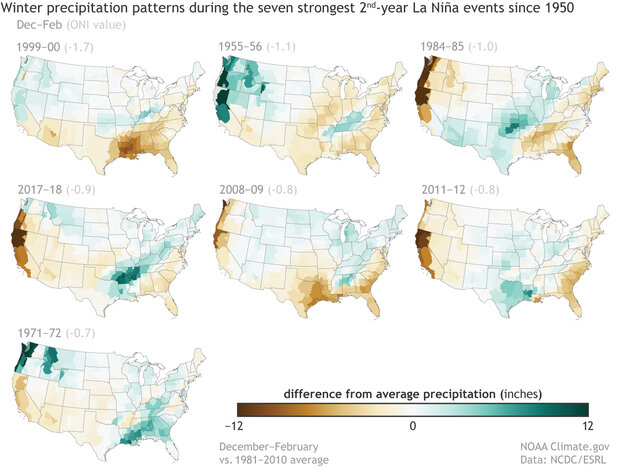El Nino and La Nina
-

NOAA released their latest ENSO outlook today. It shows that the current La Nina is expected to last through spring and should transition to neutral conditions this summer. Their latest forecast differs somewhat from last month’s in that they have lowered the chances of going into an El Nino later in the year. That means…
-

I’ve been so busy that I missed the latest La Niña outlook that was released last week. Not surprisingly, it shows we are nearly at the peak of the current La Niña and that we are expected to move back towards neutral conditions over the next few months, although perhaps not quite as soon as…
Posted in: El Nino and La Nina -

The global surface temperature for 2021 was the sixth highest since record keeping began in 1880, according to NOAA scientists. In a separate analysis of global temperature data, also released today, NASA has 2021 tying with 2018 as the sixth-warmest year on record. December’s global surface temperature tied with 2016 as the fifth highest in…
-

The latest ENSO update was released today by NOAA. It shows that the La Nina continues to be present in the eastern Pacific Ocean and these conditions are expected to last through spring. You can read the latest outlook here.
-

Yesterday we looked at the current state of La Niña and how it may affect our weather in the comings weeks and months. Today NOAA’s Climate Blog posted some additional information about La Niña and how it is described using different figures and graphs. You might find the extra information useful in understanding what La…
-

The latest ENSO discussion was released by NOAA today. It shows that La Nina is still expected to continue through the winter and that it is likely to transition to ENSO-neutral conditions sometime in the spring. You can read the discussion at https://iri.columbia.edu/our-expertise/climate/forecasts/enso/current/?enso_tab=enso-cpc_update. I will add that it is quite rare for La Nina to…
-

NOAA released their winter outlook in late November. It provides a detailed look at what to expect knowing that we are now in a La Nina that should last through the winter and into spring. You can see maps of the climate variations in each of the first- and second-year La Ninas over the last…